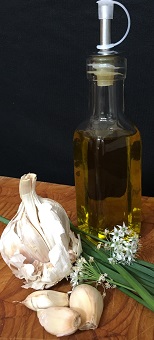 Herbs can have real benefits - but their safe use can be complicated.
Herbs can have real benefits - but their safe use can be complicated.
The main active ingredients of lavender for instance are linalool, linalyl acetate, linalyl butyrate, volatile oil, cineol, pinene, limonene, camphor, geraniol, borneol and tannin. Each of these chemicals can do different things to the body though; and the % of each chemical varies between cultivars. Some cultivars of Lavendula angustifolia will contain very little camphor (which can be toxic if ingested in quantity), but many other lavender species are high in camphor.
Even something as simple as garlic also contain a large variety of different chemicals. Garlic is known to have a wide range of beneficial medicinal effects, but the exact way it acts is not fully understood. When garlic plant cells are broken through cutting, crushing or chewing a strong odour is released. This odour is associated with the decomposition of allicin, which is a derivative of the sulphur compound 'alliin' (S-allyl-L-cysteine sulfoxide) produces allicin (diallyl thiosulfinate). When the cells are broken, the enzyme alliinase converts alliin to allicin. Other sulphur compounds, peptides, steroids, terpenoids, flavonoids, and phenols have increasingly been identified as possible active ingredients.
Another very widely used herb is peppermint. The key active constituents are menthol and menthone (significantly higher than spearmint). Also menthyl acetate, 1,8-cineole, menthofuran, limonene, pulegone, flavonoids, tocopherols, carotenoids, betaine, choline, azulenes, rosmarinic acid, beta-pinene and beta-caryophyllene. Peppermint oil possessed antiradical activity with respect to DPPH (diphenyl picryl hydrazyl) and hydroxyl (OH*) radicals, exercising stronger antioxidant impact on the OH* radical. The concentrations required for 50% inhibition of the respective radical (IC50) were 860 microg/mL for DPPH and 0.26 microg/mL for OH*. Peppermint essential oil demonstrated antioxidant activity in a model linoleic acid emulsion system in terms of inhibiting conjugated dienes formation by 52.4% and linoleic acid secondary oxidized products generation by 76.9% (at 0.1% concentration).
Using herbs whether medicinally, in cooking or cosmetics can be a very positive thing; but it should be done with a proper understanding of the herb.
You can learn to understand and use herbs more safely and effectively by studying our 20 hour short course - great professional development for anyone working with food, medicine, cosmetics or in horticulture. An essential education for you own daily living. click here